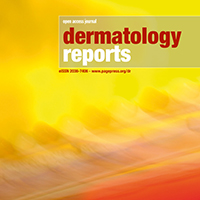Efficacy of topical photodynamic therapy in the treatment of erythroplasia of Queyrat

Accepted: 24 May 2020
HTML: 487
All claims expressed in this article are solely those of the authors and do not necessarily represent those of their affiliated organizations, or those of the publisher, the editors and the reviewers. Any product that may be evaluated in this article or claim that may be made by its manufacturer is not guaranteed or endorsed by the publisher.
Erythroplasia of Queyrat (EQ) is an intraepidermal carcinoma in situ presenting clinically as a sharply demarcated, slightly raised erythematosus plaque on the glans penis or the inner side of the foreskin. Various treatment modalities for EQ have been proposed, including electrocautery and curettage, topical 5-floururacil cream, imiquimod cream, isotretinoin, cryotherapy, laser therapy, radiotherapy, ingenol mebutate gel and photodynamic therapy (PDT). Most of these treatments are limited by low clearance rates and frequent relapses. Surgical treatment including local excision, Mohs micrographic surgery and partial or total penectomy, ensures adequate healing rates. However, discomfort consequent to surgical treatment might be unacceptable. Topical PDT using the methyl ester of 5-aminolaevulinic acid (MAL) is an established non-surgical treatment of cutaneous precancerous lesions and skin cancers. We present the case of a 60-year-old uncircumcised man affected by EQ of the penis successfully treated with MAL-PDT, performed five times, two weeks apart, with no recurrences after 6 years.
PAGEPress has chosen to apply the Creative Commons Attribution NonCommercial 4.0 International License (CC BY-NC 4.0) to all manuscripts to be published.





 https://doi.org/10.4081/dr.2020.8566
https://doi.org/10.4081/dr.2020.8566



